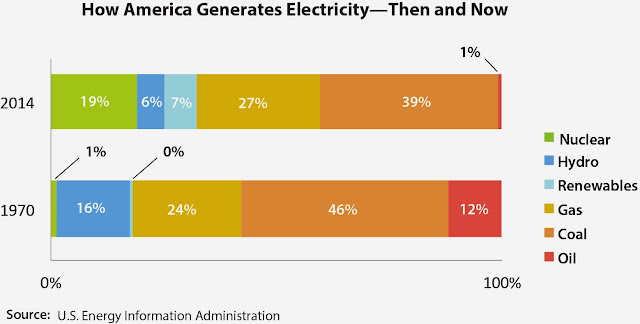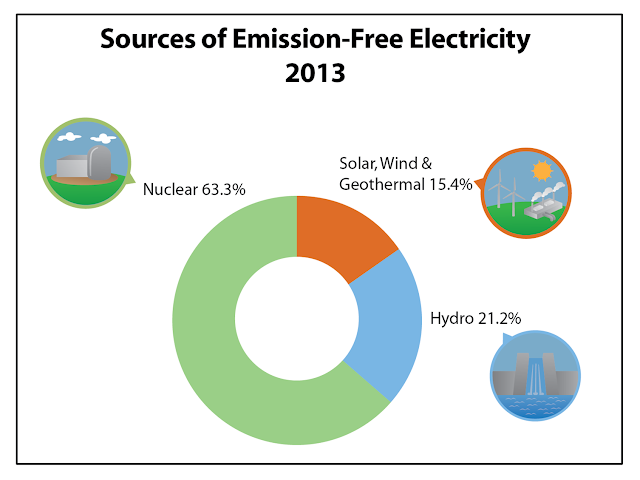Tomorrow is the 45th anniversary of Earth Day. Last year, we discussed how the U.S. electric grid had evolved since the founding of Earth Day in 1970. The updated chart below tells the story of how nuclear energy grew to produce 19 percent of America's electricity. Though it might be hard to believe, oil produced more than 10 percent of the nation's electricity on that first Earth Day. That it doesn't any longer is in large part attributable to the growth of nuclear energy and other low carbon sources of electricity on the grid.
Nuclear energy's growth over the past four and a half decades should
not be taken for granted. One of the greatest environmental challenges we face today is reducing carbon emissions while maintaining modern living standards. The electricity sector is the largest contributor of carbon emissions (one-third) in the United States, and nuclear is the only source that includes 24/7, large-scale production, industry-leading efficiency and zero carbon emissions during the production of electricity.
Most mainstream analyses of climate change policy show that nuclear energy is essential to cut carbon emissions. Yet competitive electricity markets currently undervalue nuclear's attributes, putting high-performing nuclear plants at risk of premature closure. Guess what happens when nuclear plants close? Carbon emissions go up. Just ask Germany and Japan.
Most mainstream analyses of climate change policy show that nuclear energy is essential to cut carbon emissions. Yet competitive electricity markets currently undervalue nuclear's attributes, putting high-performing nuclear plants at risk of premature closure. Guess what happens when nuclear plants close? Carbon emissions go up. Just ask Germany and Japan.
This week, Norris McDonald, the founder and president of the African American Environmental Association (AAEA), explained why we need nuclear in our arsenal to combat emissions (emphasis mine):
As the head of an organization dedicated to protecting the environment, I care deeply about reducing carbon emissions in order to improve human, animal and plant ecologies. One of the key ways to do this is to preserve our existing nuclear fleet.If the EPA is serious about reducing nationwide carbon emissions from the power sector by 30 percent below 2005 levels, not only do we need to maintain the nuclear supply to the grid, we need to expand it. In fact, earlier this year the International Energy Agency and the Nuclear Energy Agency published a report stating global nuclear generation would need to double by 2050 in order for the world to meet the international 2°C (3.6°F) warming goal.
It's a little-known fact -- especially among the environmentalist community -- that America's nuclear plants are the workhorses of our clean air energy production. Each year, these plants produce 63 percent of all the carbon-free energy generated in the U.S. These plants helped us avoid 589 million metric tons of carbon dioxide emissions in 2013. To put that in perspective, that equals the amount of carbon emissions emitted by 113 million passenger cars annually. Plus, nuclear energy's life-cycle emissions -- including any emissions from mining, fuel production, plant construction, operation, and decommissioning -- are among the lowest of all electricity sources.
Nuclear's benefits to the environment cannot be overstated. Nor can its importance when it comes to meeting climate goals. Policymakers should celebrate this Earth Day by reflecting on how much nuclear has given us, and what they can do to make sure we continue reaping its benefits.


Comments